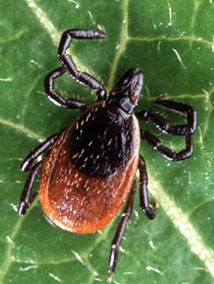Posts in Category: Fleas Ticks & Heartworm
Lyme Disease High Risk for Zimmerman Dogs
By Dr. Maria Krenz, DVM – ZimmVet
In the Zimmerman area, dogs are at a high risk for contracting Lyme disease from a tick bite. In 2023, 1 in 12 of the dogs tested in Sherburne County for Lyme disease were positive for this painful disease. Now is the time to make sure your pet is protected. The best level of protection includes using a Lyme vaccination, tick prevention products as well as checking your pet daily for ticks.

We only see a couple ticks a year on my pet, why do I need to vaccinate against Lyme disease?
All it takes is one tick bite to spread Lyme disease. Any pet that goes into long grass, brush or wooded areas is at high risk and should be vaccinated for Lyme disease. Even though ticks prefer these environments, they can be found even on short mowed lawns or traveling across hard surfaces. The immature nymph stage of the tick is very small and difficult to see. A nymph is typically the size of a poppy seed. Once Lyme disease is contracted, it can cause swollen painful joints, vomiting, diarrhea, and lethargy and can even lead to kidney failure.
My pet has been positive for Lyme is the past, so I don’t vaccinate anymore.
Often, pets will show up positive on an in-clinic test called a 4dx test, even after Lyme disease has been successfully treated. This is because the pet has antibodies or proteins in their system from the past infection. Additional bloodwork, called a titer, can tell us if a positive test means a new infection. Anytime a pet is bitten by a tick, it can be re-infected with Lyme disease. Pets that are positive for Lyme disease are at high risk for reinfection, these pets need extra protection and yearly vaccination is especially important.
I have vaccinated my pet and they still contracted Lyme disease.
Lyme bacteria is a tricky disease, and does many things to fool a pet’s body. No vaccination provides 100% protection. At ZimmVet, we administer the vaccination that provides the newest updates to Lyme technology.
Preventative Tick Products
There are many tick products on the market. Many products that can be purchased over the counter may not work as well, as they may not be waterproof or can cause side effects in the pet. When purchasing product from a veterinarian you receive the full manufacturer guarantee and backing, along with money saving rebates or free doses. At ZimmVet, we carry the top of the line tick prevention products. Bravecto is an oral chewable tick preventative that lasts for 3 months. Simparica Trio is a monthly oral chewable that is an all in one and provides heartworm prevention and deworming besides flea and tick prevention. Clients with small children especially like oral products and they do not have to worry about kids touching the pet after application. Collars and be useful in combination with other products but are typically not waterproof so can leave a pet unprotected for periods after swimming or bathing. In some pets, for added protection we combine use of products. Using more than one product should only be done under veterinary direction.
Minnesota and the Zimmerman area have a high prevalence of Lyme disease. By vaccinating against Lyme, using a proven flea and tick treatment monthly Bravecto or Simparica Trio, and removing ticks daily, you will give your pet the best chance of staying healthy.
For more information visit www.dogsandticks.com or www.petsandparasites.org
Disclaimer: This written content is meant to be educational and is not medical advice. Always consult a veterinarian about medical advice for your pet.
Preventatives for Pets

As summer comes to a close, and the cool of fall begins, everyone is preparing for sweaters and pumpkins. With the change of the season, it can be easy to forget that as we gear up for cool weather, pests like ticks and fleas do not. It is important to maintain preventatives for your pet all year round. Let’s review some of the important reasons to keep up on preventatives for your dogs and cats.
Skin Problems
One reason to use prevention against fleas and ticks is because they can cause skin problems for your pet, and your family. The tiny pests can cause irritation of the skin when they bite, leading to itching and redness. In some cases, they can cause a allergic reaction.
The Costs
In addition to irritation, the presence of fleas and ticks can quickly become overwhelming. When fleas and ticks get into your home, they can quickly populate and spread, making them difficult to get rid of. It can be very costly to treat an infestation in your home, and can take more than one treatment because of the varying lifecycle of the little bugs.
On top of this, if your pet is infested, they will also need treatments. This can range from flea dips to topical and oral medications in order to get rid of the pests.
Preventatives Stop Illness
The number one reason for preventatives is to stop the spread of illnesses from fleas and ticks to your pets. There are a variety of illnesses that these small bugs can carry, and spread to your pets and your family. Fleas in the US commonly transfer flea-borne tape worms, cat scratch fever (bartonellosis), murine typhus, and flea-borne spotted fever.
Ticks can spread illnesses such as Lyme disease, anaplasmosis, leptospirosis, Rocky Mountain spotted fever, rickettsiosis, and more. Fleas and ticks spread these illnesses through their bites. The more they bite, the more likely the to infect your pet. Preventatives are designed to lower the chance by killing off fleas and ticks when they get on your pet and try biting them.
Does my pet need preventatives?
The short answer is – Yes! Fleas are small, and move quickly. Ticks can also be easily missed, ranging in size from as small as a poppy seed, to as large as the eraser on a pencil. It can be difficult to find these pets on your pets, especially cats since they groom themselves so often!
Even if your pet is an indoor cat, or a small dog that rarely goes outside – they still need preventatives! All it takes to pick up fleas or ticks, is for you to have them on your clothes when you come inside. Even a brief step outside by your dog to use the bathroom can expose them.
As a result, by the time you notice the presence of fleas or ticks in your home or on your pet, it may already be too late. Veterinarians recommend you keep your pet on preventatives year-round. Here in Minnesota, these pests are present all year.
You can read more about Flea and Tick Prevention from our previous blog. You can look up prevalence of tick and flea borne illness near you checking out the Parasite Prevalence Maps.
April: Prevention of Lyme Disease in Dogs Month
As temperatures rise, we will see more and more activity from bugs and creepy crawlies. This means your dog’s risk of contracting preventable illnesses will increase too! Lyme, and several other illnesses, are carried by ticks and spread through their bite. While ticks are out year round, the spring and summer see a significant increase in their numbers. That is why April is a great time to discuss the hazards of Lyme, and ways to protect your pet!

Where Do Dogs Get Lyme?
Lyme Disease in Minnesota is a well known risk for both people and dogs alike. According to The Companion Animal Parasite Council (CAPC), there have been over 109 confirmed cases of Lyme disease in Sherburne County alone, and 4,189 cases across Minnesota in the first few months of 2024.
The risk is very present, and those numbers are, unfortunately, expected to rise. Ticks are typically found in environments with heavy vegetation, like forests or grassy areas, like when you go hiking or camping. However, they can also be found in your own back yards. They are also common near bodies of water or in marshy areas.
Symptoms of Lyme Disease and Treatment
If you are worried your pet is getting ill, here are some common symptoms associated with lyme:
- Limping that starts and stops again
- Less interest in eating or complete loss of appetite
- Decreased activity, laying around often
- Swollen lymph nodes
- Painful and swollen joints
- Fever
Call your veterinarian right away to discuss the symptoms and risk factors your pet has for Lyme, including their exposure to ticks and their symptoms. To diagnose your pet, the veterinarian will want to run lab tests to rule out other illnesses and to confirm the Lyme diagnosis.
Once diagnosed, they will begin a course of antibiotics to fight back against the illness. This can take a month or longer to resolve itself.
Preventing Lyme Disease
The best way to avoid your pet getting sick is to be proactive in protecting them. A reliable tick-preventative product recommended by your veterinarian, as well as vaccination, are the strongest protections for your dog.
Additionally, you can also:
- Mow your grass, trim bushes, and remove unnecessary brush piles to make your yard less friendly to ticks.
- Inspect your pet when coming in from outdoor activities. Check their bodies over, including particularly tick-favored spots such as ears, legs, tails, and under their collar. Remove ticks you find immediately, wrapping them in tape or flushing them to dispose of them.
If you do find a tick on you or your pet, be sure to get checked for Lyme disease to be on the safe side. It can take 3 to 4 weeks before symptoms start.
Talk to your veterinarian today about prevention options.
To learn more about Lyme Disease, you can also visit another of our blogs on Lyme disease Prevention.
Disclaimer: This written content is meant to be educational and is not medical advice. Always consult a veterinarian about medical advice for your pet.


